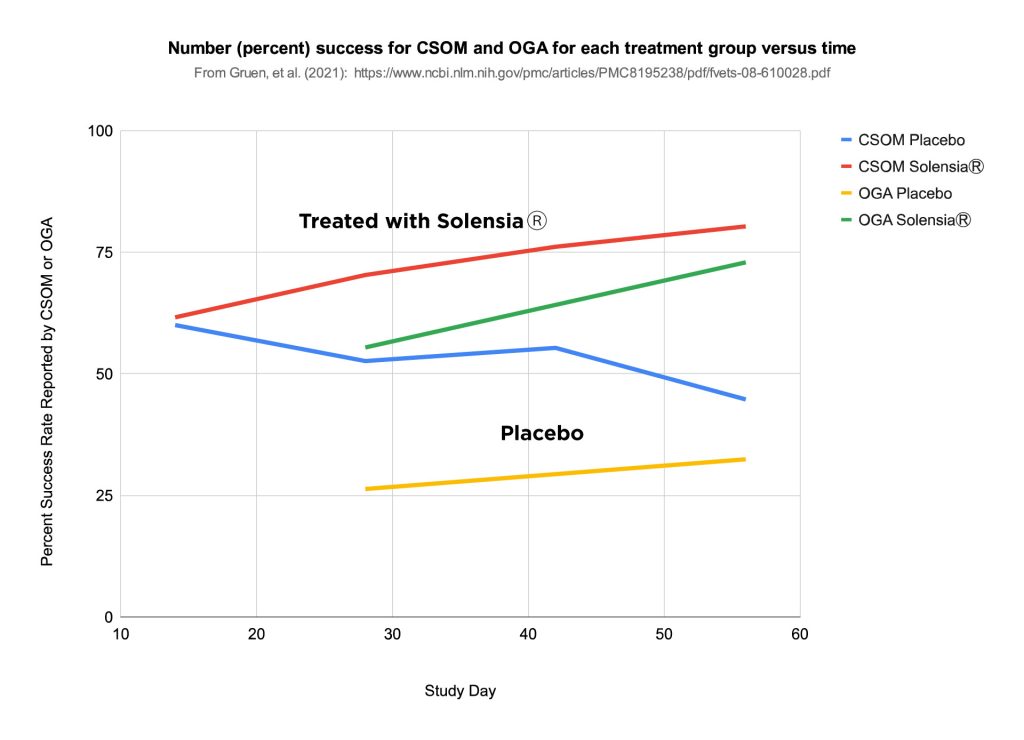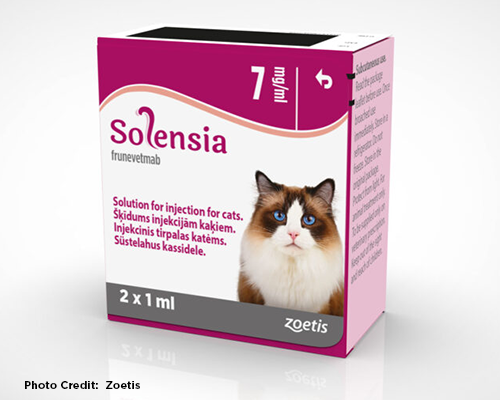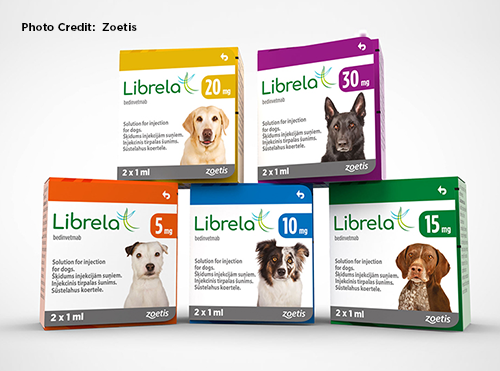This post is very close to my heart because of the difference SolensiaⓇ has made in the quality of life of our long-haired calico geriatric cat, Rosie. In 2005, she came to us from Dane County Friends of Ferals in Madison, Wisconsin mostly because of her boisterous personality. She has always loudly greeted guests into our home. As of this update, she's 19 years old. (BTW, I shot these images of Rosie with an iPhone 😉).

A couple of years ago, Rosie began sleeping more and developing mats because she was not grooming herself well. She also lost weight. My husband, Greg, an American College of Veterinary Medicine (ACVIM) board-certified veterinary internist, tried giving her gabapentin (an analgesic) but it was nearly impossible to give Rosie a medication orally. Any pet owners who have tried to "pill" a cat understand!
Earlier this year (2022), he learned of the breakthrough treatment, SolensiaⓇ, for treating the pain of osteoarthritis in cats at a continuing education event held by Zoetis Services LLC in Park City, UT. Solensia had been approved for use in the European Union in February of 2021. Very intrigued, he got one of the first doses available in the United States and gave Rosie her first shot in July, 2022. Within about two weeks, she experienced improvement, and we started getting our old Rosie back! She started loudly asking to get up in my lap while I work at my desk again and jumping up on the back of the couch to groom Greg while we watch TV at night. Her quality of life has improved so much that we can't help but highly recommend SolensiaⓇ to fellow cat owners who have seen signs of their cat's pain. Update February 13, 2024: Rosie is still going strong and even jumping up on my desk!

Solensia for Cats (active ingredient frunevetmab injection) for cats, the newest feline OA treatments to enter the market, is an effective and safe way of controlling feline osteoarthritis pain. It is an injectable monoclonal antibody therapy that can control osteoarthritis pain in cats. Frunevetmab was approved by the U.S. Federal Drug Administration (FDA) for OA pain in cats on January 13, 2022. It is important to remember that SolensiaⓇ is not a cure for OA, but it can help control the pain associated with the condition. As with all medications, it is important to consult with your veterinarian to discuss any potential adverse reactions to this medication or alternatives. With the right care and attention, you can ensure that your cat remains pain-free and comfortable into their golden years.
In this blog post, I'll take an in-depth look at SolensiaⓇ, from how it works to what side effects you might expect. Let's dive in!
What Is Cat Osteoarthritis (OA) Pain?
Osteoarthritis (OA) pain is a VERY common problem that affects cats as they age. It can be caused by various factors, including genetics, injury, obesity, and underlying medical conditions. It can affect any joint in the body, but it is most commonly seen in the hips, knees, and ankles. Osteoarthritis is a progressive degenerative joint disease (DJD) that causes the cartilage in the joints to break down, leading to inflammation, pain, and stiffness. In clinical studies, osteoarthritis was detected in 61% of cats older than 6 years of age, and 90% of cats older than 12 years of age. Feline OA pain is often untreated due to the challenges to cat owners of administering oral medications.
Feline Osteoarthritis Pain Diagnosis and Treatment
Osteoarthritis (OA) pain in cats can be a real challenge to diagnose and manage. Unlike dogs, cats are less likely to tell you about painful joints. Instead, they hide their pain as a survival instinct. Although OA pain is not curable, there are various treatments available that can help your feline friend stay as active and comfortable as possible. Although OA pain is not curable, there are various treatments available that can help your feline friend stay as active and comfortable as possible. After all that's what we're all looking for for our companion animals, right?
Senior cats are at higher risk for OA pain, as are large breeds. As a result, it's important to monitor your cat's weight and appetite. If your cat is overweight, it should begin a supervised exercise program. Your veterinarian will also want to determine if your cat's pain is due to other medical conditions. X-rays (radiographs) can help your vet find out more about your cat's condition.

Control of chronic pain due to OA in cats often involves a combination of approaches, including pain management, weight control, and physical therapy. Many vets used to recommend using non-steroidal anti-inflammatory drugs (NSAIDs), like meloxicam, to manage pain and inflammation, but these medications can have side effects, such as stomach ulcers and kidney damage. The older your cat gets, the more likely it is that it will not be able to take NSAIDs. For this reason, gabapentin is often used to complement NSAIDs for the control of pain. Dietary supplements including glucosamine and chondroitin can help to support joint health and reduce inflammation. Finally, physical therapy, such as massage, heat therapy, and exercises, can help to improve mobility and reduce pain in cats with osteoarthritis.
Is Your Cat Showing Signs of OA Pain?
Osteoarthritis is a very common condition in cats, and the symptoms may include:
Difficulty walking, climbing stairs, or jumping
Lameness or limping
Decreased activity or exercise tolerance
Decreased grooming or reluctance to be touched
Weight gain or loss
Changes in behavior, such as irritability or aggression
If you notice that your cat is showing signs of pain or reduced mobility when moving around, it may be time to consider consulting your animal healthcare professional. They can perform an osteoarthritis screening and may use radiographs (X-rays) to diagnose the degree of your cat’s pain.

Solensia for Cats is the first once-monthly monoclonal antibody therapy that controls feline osteoarthritis (OA) pain
SolensiaⓇ(TM) from Zoetis is a new and effective treatment for cats with osteoarthritis pain. It is a once-a-month injectable therapy that helps to reduce both pain and inflammation, helping cats live comfortable and pain-free lives. Not only does this therapy work effectively in pain relief, but it also helps to reduce inflammation - something that has been shown to help improve joint function and relieve symptoms in cats with OA over time. It also binds strongly to proinflammatory cytokines, which helps stop the inflammatory response before it becomes a problem.
Monthly injections of can keep your cat comfortable and mobile for months or even years without having to resort to daily oral medications or other treatments for OA pain control. If you're considering using SolensiaⓇ as part of your cat's arthritis management program, talk to your veterinarian. She/he will be able to give you more information about the therapy and help you decide if it's the right option for your cat.
Solensia for cats is a proven safe treatment option with minimal impact on the liver, kidneys, and gastrointestinal tract. This makes it suitable for cats with gastrointestinal sensitivities, chronic kidney disease, and other illnesses.
How Does Solensia for Cats Work?
Significant strides in the measurement of chronic pain in companion animals have been made over the last 20 years. A notable discussion of these advances was held at the 2017 Pain in Animals Workshop and was published by Lascelles BDX, Brown DC, Conzemius MG, Gill M, Oshinsky ML, and Sharkey M. Early clinical trials were conducted by Enomoto M, Mantyh PW, Murrell J, Innes JF, Lascelles BDX and published in the Veterinary Record in 2018.
The safety of an anti-nerve growth factor antibody in cats was jointly studied by Gruen ME , Myers JAE, and Lascelles BDX, investigators from North Carolina State University and Zoetis (published in 2021). They concluded that frunevetmab removes the need to medicate cats orally, which can be traumatic for many cat owners, cats, and the human–animal bond itself. SolensiaⓇ is a novel therapy now available in veterinary medicine with the potential to dramatically increase the treatment of OA pain in cats.
Solensia for Cats targets a specific protein called Nerve Growth Factor (NGF), which is linked to joint pain signaling and inflammation. . The monoclonal antibodies work quickly and effectively to inhibit NGF and reduce the feline OA pain signal activated and perpetuated by NGF. Cat owners and DVMs administering the injections report very few adverse events - making it a safe treatment for your cat. Pain relief due to SolensiaⓇ can be seen within two weeks after administration and can last up to 30 days in some cases. Unlike NSAIDs and other analgesic that are typically administered orally, SolensiaⓇ does not cause gastrointestinal upset, ulcers or kidney damage in cats.
The safety of an anti-nerve growth factor antibody in cats was jointly studied by Gruen ME , Myers JAE, and Lascelles BDX, investigators from North Carolina State University and Zoetis (published in 2021). They concluded that frunevetmab removes the need to medicate cats orally, which can be traumatic for many cat owners, cats, and the human–animal bond itself. SolensiaⓇ is a novel therapy now available in veterinary medicine with the potential to dramatically increase the treatment of OA pain in cats.
How Much Does Solensia for Cats Cost?
Since SolensiaⓇ must be injected by a veterinarian, so the cost is a combination of the medication's cost and an appointment fee. An injection typically costs $80-$100 in the United States, including the appointment.
How Is Solensia for Cats Administered?
SolensiaⓇ is a subcutaneous injection administered once monthly at your veterinary clinic. It can be easily given in the veterinary clinic or at home without requiring anesthesia or hospitalization, making it an ideal treatment for cats. The injections must be given on the same day of every month to ensure consistency with dosage levels and effectiveness.
What is the Success Rate of Solensia for Cats?
The success rate of SolensiaⓇ can vary depending on individual cats and their specific conditions. The efficacy (success rate) and safety of frunevetmab was studied by Dr. Margaret E. Gruen, DVM and colleagues at North Carolina State University and published in 2021 in Frontiers of Veterinary Science. They used an owner completed Client Specific Outcome Measures (CSOM) combined with secondary outcome measures, the Feline Musculoskeletal Pain Index (FMPI), accelerometry data (an activity monitor), the Owner Global Assessment (OGA), and veterinarian assessments.
Statistically meaningful differences between a group of cats given frunevetmab and a placebo group were observed for days 42 and 56 (see the chart below). Each cat had two treatments 28 days apart. The OGA simply asked the owner to rate the level of clinical signs with a score of Excellent, Good, Fair or Poor on days 28 and 56. The chart below shows the results of both CSOM and OGA questionnaires reported by owners. The success rate of frunevetmab is roughly between 75-80% at treatment day 56.

Potential Side Effects of Solensia for Cats
The most common side effects in a clinical trial were nausea and pain at the injection site. If the medication is not properly administered or if your cat has an allergic reaction to SolensiaⓇ, your cat could experience vomiting, vomiting, diarrhea, injection site pain, scabbing on the head and neck, dermatitis and pruritus (itchy skin) and excessive licking at the injection site. If you notice any of these signs after administration of SolensiaⓇ, contact your veterinarian immediately!
Safety Issues with Solensia for Cats
SolensiaⓇ is only for use in cats. Women who are pregnant, trying to conceive or breastfeeding should take extreme care to avoid self-injection, which can cause hypersensitivity reactions. Adverse reactions of self-injection include allergic reactions, including anaphylaxis. Here's the link for full prescribing information.
SolensiaⓇ should not be used in breeding cats or in pregnant or lactating queens. It should not be administered to cats with known allergy to frunevetmab.
The Bottom Line: Reducing pain helps improve the quality of life for your cats.

Is There a Version of Solensia for Dogs?
Update (5/9/23) YES!! Librela for Dogs (bedinvetmab) was approved by the FDA for use in the United States on May 5, 2023!! It should be commercially available in late 2023.
Librela for Dogs is a similar monthly injection for dogs that demonstrated a reduction in OA pain when compared to placebo-controlled dogs. Dog owners saw a reduction in pain and increase in physical activity levels. I'm so excited as our Dream is 13 years-old!

SolensiaⓇ and LibrelaⓇ are registered trademarks of Zoetis, Inc. This post is an unpaid review of these products based on personal experience. We have no affiliation with Zoetis or any of its subsidiaries.
Frequently Asked Questions
What is the impact of osteoarthritis pain on a cat’s quality of life?
Chronic pain from OA impacts several aspects of a cat's life simultaneously, including: lameness or limping, decreased activity or exercise tolerance, decreased grooming or reluctance to be touched, weight gain or loss, irritability or aggression, relationships with both their human family and other pets.
What are the signs of OA pain in cats?
Osteoarthritis is a very common condition in cats, and the symptoms may include:
- Difficulty walking, climbing stairs, or jumping
- Lameness or limping
- Decreased activity or exercise tolerance
- Decreased grooming or reluctance to be touched
- Weight gain or loss
- Changes in behavior, such as irritability or aggression
What is the best treatment for arthritis in cats?
The best treatment for arthritis in cats will depend on the severity of their condition. However, there are several options available that can help to ease their pain and improve mobility.
Solensia for Cats, a new monoclonal antibody treatment that controls OA pain and inflammation,
non-steroidal anti-inflammatory drugs (NSAIDs) to reduce pain and inflammation,
physical therapy such as massage, range of motion exercises, and hydrotherapy to improve mobility, and
supplements like glucosamine, chondroitin, and other joint-supporting supplements to help maintain joint health.
Is SolensiaⓇ available for cats?
Yes!! It was approved for use in the U.S. by the Food and Drug Administration on January 13, 2022.
How does SolensiaⓇ work?
SolensiaⓇ's monoclonal antibodies target Nerve Growth Factor (NGF), which is linked to joint pain and inflammation. The monoclonal antibodies work quickly and effectively to reduce the pain signal activated and perpetuated by NGF. There are also very few side effects or reactions reported by owners or veterinarians administering the injections - making it a safe treatment for your cat. The benefits of SolensiaⓇ can be seen within two weeks after administration and can last up to 30 days in some cases. Unlike NSAIDs that are typically administered orally, SolensiaⓇ does not cause gastrointestinal upset, ulcers or kidney damage in cats.
What is the success rate of SolensiaⓇ?
The success rate of SolensiaⓇ has been estimated at about 75-80% at day 56 of treatment, but it really depends on the individual cat and any other conditions that might be present.
How long does it take for SolensiaⓇ to work in cats?
The benefits of SolensiaⓇ can be seen within two weeks after administration and can last up to 30 days. Injections must be given consistently on a monthly basis in order for the benefits to continue.
How is Solensia for Cats administered to cats?
SolensiaⓇ is a subcutaneous injection administered once monthly by a veterinarian.
What are the benefits of using SolensiaⓇ for cats?
SolensiaⓇ helps to reduce both pain and inflammation, helping cats live comfortable and pain-free lives. Not only does this therapy work effectively in relieving pain, but it also helps to reduce inflammation, helping to improve joint function and relieve symptoms in cats with OA over time. SolensiaⓇ also helps stop the inflammatory response of OA before it becomes a problem. Monthly injections of SolensiaⓇ can keep your cat comfortable and mobile for months or even years without having to resort to daily oral medications or other treatments for OA pain control.
Is it safe to use Solensia for cats?
Solensia for Cats has few side effects including allergic reaction, vomiting and excessive licking at the injection site. If you're considering using SolensiaⓇ as part of your cat's arthritis management program, talk to your veterinarian. She/he will be able to give you more information about the therapy and help you decide if it's the right option for your cat.
Is LibrelaⓇ Available for Dogs?
Update (5/9/23) YES!! LibrelaⓇ (bedinvetmab) was approved by the FDA for use in the United States on May 5, 2023!!
Content reviewed and approved by Dr. Gregory M. Kuhlman, DVM, DACVIM (SAIM)
Dr. Kuhlman earned his Doctor of Veterinary Medicine degree from the University of Wisconsin. Following an internship in small animal medicine and surgery at the VCA Animal Emergency and Referral Center of Arizona, he completed a residency in internal medicine at Texas A&M University. Dr. Kuhlman enjoys all aspects of internal medicine, but he has a special interest in gastrointestinal, hepatobiliary, immune-mediated and infectious diseases. He has a passion for the treatment and management of the canine athlete and has been competing in and judging English springer spaniel field trials for over 20 years. He has a special interest in treating the canine athlete. On his days off, he can usually be found out training his dogs for AKC field trials, hunting upland game with his dogs, fly fishing or training for Ironman triathlons.


